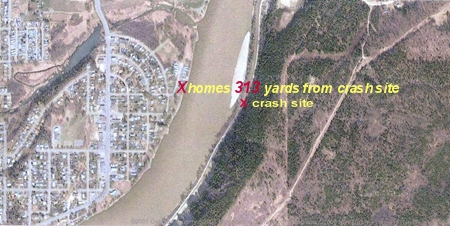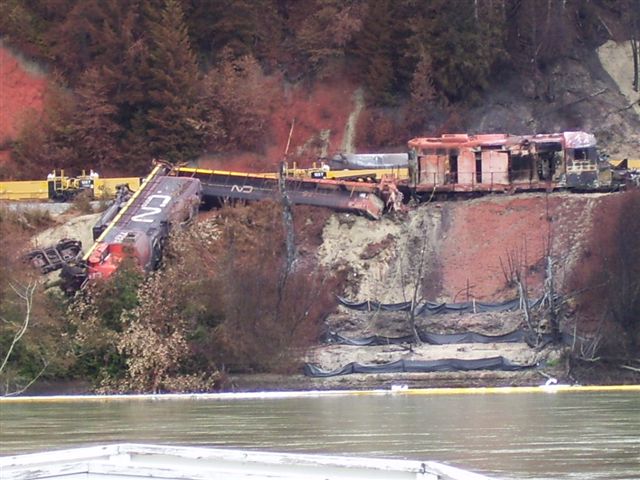CN Derailment A Close Call
By 250 News

Distance between derailment and residential areas, just 313 yards (288 meters) apart.
Did residents of the Prince George neighbourhood of “South Fort” dodge a bullet on the weekend when two CN trains collided on the tracks on the east side of the Fraser River?
The collision took place at 10:20 a.m., one train contained cars moving lumber products, and the other was hauling a host of tank cars. It appears that while CN executives knew what the tankers contained, others on the scene trying to prevent a potential disaster did not.
When asked if there were dangerous or hazardous products contained in any of the tank cars, Assistant Deputy Fire Chief John Lane said CN reps were on hand with the manifest, but just as soon as the train was uncoupled and the cars moved away from the scene, he had no reason to ask. ‘They were pulled from the scene so fast we didn’t know what was contained in those other tanker cars” said Lane.
The call to the fire department was received around 10:20 in the morning. Lane did a briefing with me mbers of the media at noon. At that time, the tanker cars, with the unknown contents, were still coupled to the train. They are visible in the background of a digital photo taken at the time (see photo at right, taken at 12:02 p.m.)
mbers of the media at noon. At that time, the tanker cars, with the unknown contents, were still coupled to the train. They are visible in the background of a digital photo taken at the time (see photo at right, taken at 12:02 p.m.)
While CN is not commenting, it is known that if it hadn’t been for the heroics of a CN employee who rushed to the derailment and uncoupled the two trains from the burning or at risk cars, the scenario might have been very different.
According to Lane, the car that was immediately to the north of the gasoline tank car contained either diesel or gasoline, but that is as far he went. Police sources say they were never informed about what was contained in the other cars.
CN spokesperson Kelli Svendsen, says the railway will not release the manifest of what was in the other cars as “they weren’t part of the incident”. Nor will CN release the name of the person who rushed in to uncouple the cars; it is not the company’s practice to release names of employees. One insider tells Opinion250 the person who risked their life to uncouple those cars may very well face discipline for putting himself in harms way.
.According to the safety standards employed by emergency response teams in all of North America, when dealing with a derailment like the one that happened in Prince George Saturday, the perimeter around the scene should be, at minimum, 800 meters, or ½ a mile.
The distance from Paddle Wheel Park to the derailment site was a mere 313 yards, or 288 meters.
 (At left, the mess after the flames were out, photo submitted by Opinion250 reader "VOCER")
(At left, the mess after the flames were out, photo submitted by Opinion250 reader "VOCER")
CN says while it has concluded it was human error that caused the collision, all other information on the crash will have to come from the Transportation Board which is conducting an investigation.
The Union (UTU) appears to have been vindicated in its claim that CN was moving too many cars. A notice of orders delivered to CN calls for a maximum of 40 cars of which ten must be empty, or a total of 30 “loads”. The Transportation Board also ordered an end to the Point of Protection Zone, saying it gave a false sense of security that there were no other trains in the area, and there was an order that an employee must be on the lead equipment and visual contact be kept with the tracks at all time during switching. Opinion250 had been told the trains were being switched by “remote control”.
CN has taken immediate action to comply with the 5 orders it has been given.
Previous Story - Next Story
Return to Home









The hysteria generated by the CN smoke could have most gas stations and propane fill up stores moved out of the city. You can never be too safe if you are dodging a bullet.
I wonder how much TNT would have to be set off at the CN site to rattle the windows? I wonder if City Council will ask Crescent Spur not to ship their dynamite with CN? City Council will certainly think up something remotely important to "act on" and look impotant.